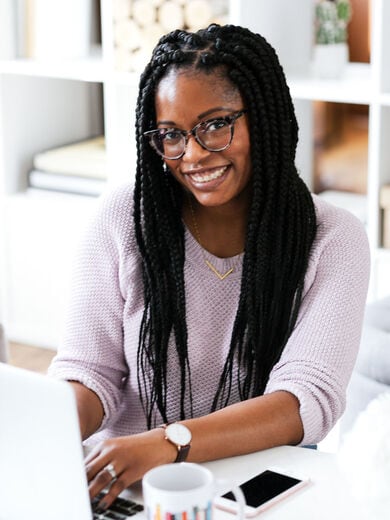
Arts as Activism for Black Students
In these dual pandemics of COVID-19 and systemic racism, supporting the artistic growth of Black students is more important than ever before.
In May 2018, my mentee, Eva Lewis, invited me to watch her headline a slam poetry event. Of course, I said yes. As my Uber pulled up to the venue, the home of Young Chicago Authors in Wicker Park, I knew I was in for a treat.
From the moment the first student stepped on stage to the second Eva put down the mic, I was enthralled. During Eva’s set, she used her voice to speak on matters important to her—Black liberation, intersectionality and poverty-induced gun violence—intersplicing poetry with gospel songs. Her performance was moving and reminded me of the role art plays when it comes to activism, now more than ever.
Art goes beyond self-expression. It’s a way to connect with your culture. It’s a form of self-care and, especially during the racial reckoning of 2020, it’s become even more prominent as a form of activism and healing. Black creativity and art as activism are more prevalent than ever before, thanks to social media. But it’s a marriage as old as time.
In 1984, poet Sonia Sanchez wrote, “The Black artist is dangerous. Black art controls the ‘Negro’s’ reality, negates negative influences, and creates positive images.” The passage derives from Black Women Writers at Work and was in reference to the Black Arts Movement.
Described as “the aesthetic and spiritual sister of the Black Power concept,” the Black Arts Movement was founded by poet Amiri Baraka and lasted from 1965 to 1975. More than 40 years later, it's clear to me that Gen Z is carrying the torch.
By now, we’re aware of the educational benefits of arts education. According to edutopia, an arts education can help “students develop skills like resilience, grit, and a growth mindset to help them master their craft, do well academically, and succeed in life after high school.” But unsurprisingly, disparities exist among racial groups and socioeconomic status. A 2016 arts assessment from The Nation Assessment of Educational Progress (NAEP) demonstrated that, on a scale of 300, white students scored an average 29 points higher than Black students in music and 30 points higher in visual arts.
As writer David Loewenberg noted in an Education Writers Association post about the story, “students eligible for free and reduced-price lunch, which is often used as a proxy to identify low-income students, scored an average of 26 points lower in music than those not eligible and 22 points lower in visual arts, both statistically significant figures.”
Infusing the arts and exposure to cultural experiences into a school curriculum has additional benefits. A 2012 report from the National Endowment for the Arts shows that “high-arts, low-socioeconomic students” are more likely to graduate from high school, attend and graduate from college, as well as register to vote when compared to “low-arts, low-socioeconomic” students.
Beyond that, the arts can also help students become more self-confident, as evident in a recent New York Times article featuring young Black poets from across the country.
“Throughout high school and middle school, I was bullied very, very severely and writing was the one way I coped. And it helped me see that I was worth more,” Alora Young, a 17-year-old high school senior and Nashville’s 2020 Youth Poet Laureate, shared in the visual collection.
I can relate. As an awkward Black girl growing up outside of Baltimore, I was teased for skipping fourth grade, “talking white,” and liking *NSYNC and Britney Spears. Classmates called me an Oreo—Black on the outside and white on the inside.
I turned to writing as solace. My journal was the one place I could express myself freely. It was cathartic to recap the day and pour out my emotions onto paper. Here, I didn’t have to worry about how I talked or what kind of music I liked, I could just be me.
That practice continued into high school, where I would become editor-in-chief of both the student newspaper and literary magazines. My monthly column is where I found my voice and realized writing was not only helpful for me, but that my words had the power to inspire and galvanize others as well. And I’ve been using my platform as a writer ever since.
But when students don’t receive an opportunity to flourish or aren’t able to carve out dedicated schooltime to hone their crafts, the world loses out on their creative genius. I attended private school throughout my entire educational career and had access to teachers, programs and extracurricular activities that gave me space to write and dream—to create.
With arts funding often being the first line item to go when budgets are on the chopping block, programs like Young Chicago Authors provide a space and platform for young creatives to use their work to make a difference in their communities and beyond.
And today’s Black and Brown creators are finding innovative ways to express themselves. Whether it’s a viral video on TikTok or an informative thread on Twitter or #BlackLivesMatter-themed streetwear and statement tees, young people are elevating their voices, their art, and their skills to draw awareness to matters that are important to them.
Kai Harris, a theater student in Mount Laurel, NJ, with more than 334,600 TikTok followers told NPR this summer, “I do not want to grow up in a world where this keeps happening, so I decided, 'You know what? I've been silent on these issues sometimes. I don't share my opinions, but I need to share them now.’”
The personal is political and so is the art. For many students, it’s about being part of something bigger than themselves and contributing to a global conversation. Between the two pandemics —COVID-19, which has disproportionately claimed more Black and Latinx lives in the U.S., and the current racial reckoning surrounding the high-profile murders of George Floyd and Breonna Taylor, among others—young artists and activists are taking matters into their own hands, and we need more arts education funding to support them.
As Toni Morrison once said, “This is precisely the time when artists go to work. There is no time for despair, no place for self-pity, no need for silence, no room for fear. We speak, we write, we do language. That is how civilizations heal.”

The opinions expressed in this piece, and all others in our Opinion section, represent those of the authors and do not necessarily reflect the views and opinions of the Teach For America organization.
We want to hear your opinions! To submit an idea for an Opinion piece or offer feedback on this story, visit our Suggestion Box.
Sign up to receive articles like this in your inbox!
Thanks for signing up!
Content is loading...








